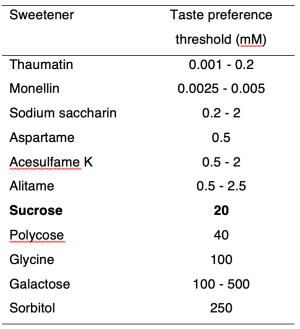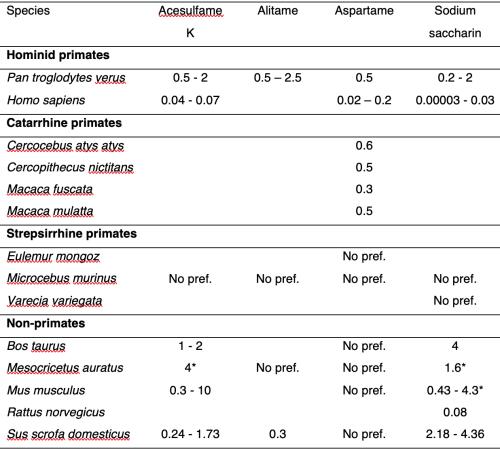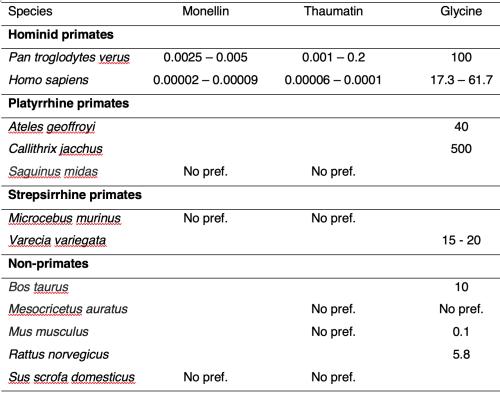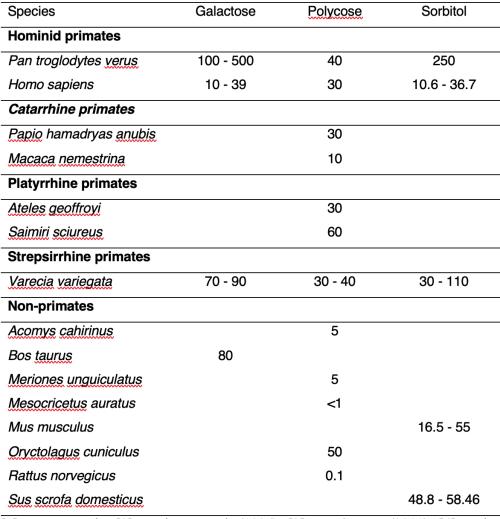Discussion
Sweetening potency order
Table 1 shows the ranking order of sweetening potency of the sweeteners used in the current study, as well as sucrose which is included for reasons of comparison. The chimpanzees were most sensitive to monellin and thaumatin, and least sensitive to galactose and sorbitol. The two sweet-tasting proteins and the four artificial sweeteners all had lower taste preference threshold values than sucrose, which means that they can all be described as high-potency sweeteners for the chimpanzees. The remaining sweeteners all had higher thresholds than sucrose, which means they can be described as low-potency sweeteners for the chimpanzees. This categorisation (of high- or low- sweetening potency) matches that reported for humans. Furthermore, there was a significant correlation in the ranking order of sweetening potency between chimpanzee and humans.

Between-species comparisons of taste preference thresholds
Artificial sweeteners
The chimpanzee taste preference thresholds for the artificial sweeteners were all higher than the human taste detection thresholds, but were within the same order of magnitude. It should be noted that taste detection thresholds are established in humans using sophisticated signal detection procedures, and thus establish the lowest concentration at which subjects can detect a given substance. In contrast, taste preference thresholds establish the lowest concentration at which a substance is preferred over water. As it is possible that lower concentrations of a substance may be detected but not significantly preferred by an animal, taste preference thresholds only provide a close approximation of an animal’s ability to detect a substance. It is thus possible that chimpanzees may be able to detect concentrations of the artificial sweeteners as low as humans can.
The chimpanzee taste preference thresholds for acesulfame K and sodium saccharin fall within the range of thresholds reported in non-primate species, suggesting a similarity in sensitivity to these two sweeteners. The chimpanzee taste preference thresholds for aspartame fall within the range of values reported for other catarrhine primates, which do not vary considerably. This suggests a similarity in sensitivity towards this sweetener within this taxon.

Sweet-tasting proteins and amino acids
For both monellin and thaumatin, there is a lot of variation in the human detection thresholds which makes useful comparisons with chimpanzees difficult. However, the lowest chimpanzee values are roughly within the same order of magnitude as the highest human values, which suggests chimpanzees and humans may not vary significantly in their sensitivity to these two proteins. There are no published taste preference thresholds for monellin or thaumatin in any other species. In common with aspartame, other studies show that only catarrhine primates prefer thaumatin over water. This suggests that there may be phylogenetic explanations for differences in taste responsiveness to these two proteins.
Amongst non-human primates, chimpanzees are less sensitive to glycine than black-and-white ruffed lemurs (Varecia variegata) and spider monkeys (Ateles geoffroyi), but more sensitive than marmosets (Callithrix jacchus). This raises the possibility that sensitivity to glycine may correlate positively with degree of frugivory. Chimpanzees consume relatively more fruit than marmosets, but less than ruffed lemurs and spider monkeys.

Sweet-tasting saccharides
The chimpanzee taste preference thresholds for galactose, polycose and sorbitol are all higher than the human taste detection values, but they are within same order of magnitude.
The chimpanzee threshold value for polycose falls within the range reported for other non-human primate species. Differences in sensitivity to polycose may relate to differences in the amount of starch in diets between primate species, since polycose is a soluble starch. Amongst non-primate species, rodents such as spiny mice (Acomys cahirinus), rats (Rattus norvegicus), hamsters (Mesocricetus auratus) and gerbils (Meriones unguiculatus) all have lower threshold values than non-human primate species and are therefore more sensitive to polycose. This may be explained in terms of diet, as rodents have high-starch diets. Studies suggest that rats may perceive starch in a unique way, independent to that of sugars, and therefore may possess a specialised starch taste receptor.
Chimpanzees are less sensitive to sorbitol than black-and-white ruffed lemurs (Varecia variegata). As sorbitol is found in nature in some fruits, this difference in sensitivity could be explained by degree of frugivory. Black-and-white ruffed lemurs are highly frugivorous and are thought to consume relatively more fruit in their diet than chimpanzees.

Responsible for this page:
Director of undergraduate studies Biology
Last updated:
05/19/19
